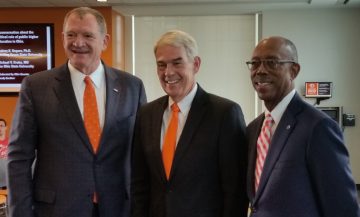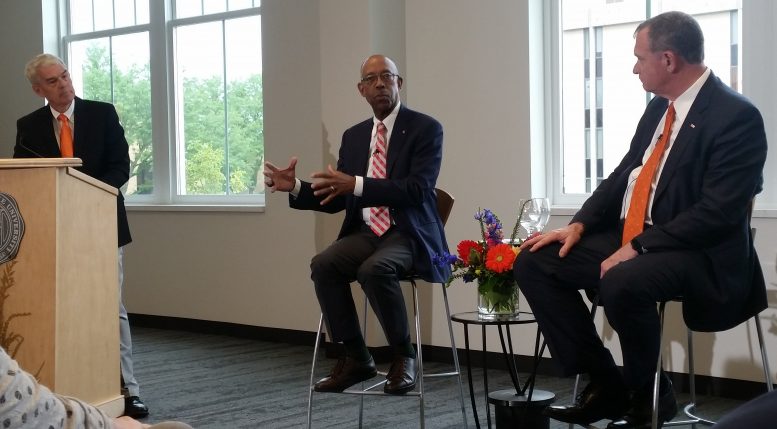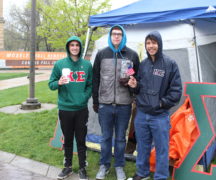By JAN LARSON McLAUGHLIN
BG Independent News
Several decades ago, college was affordable for a few, and a dream for all the others. A few decades later, college was the place kids were expected to go to start their futures. Now, the pendulum has swung back again, with college costs and job prospects leading to a push in the trades.
But BGSU President Rodney Rogers and OSU President Michael Drake held a public conversation Wednesday evening about the lasting value of higher education.
“Higher education is a value to young people, a value to our communities, a value to our state,” said State Senator Randy Gardner, R-Bowling Green, who moderated the conversation.
A college degree makes a person more employable, according to the U.S. Bureau of Labor Statistics. The unemployment rate for someone with a master’s degree is 2.2 percent; a bachelor’s degree is 2.5 percent; an associate’s degree is 3.4 percent; and a high school education, 6.8 percent.
And more than 80 percent of the country’s top 100 jobs require a bachelor’s degree.
“There’s real value there,” said Gardner, who both Rogers and Drake called a strong advocate for higher education.
A college degree also results in bigger paychecks. It offers a better annual return for investment (average 13.7 percent) than the stock market (average 10 percent), Drake said.
“It’s really about the best investment a person can make in their future,” the OSU president said.
Over a lifetime, that investment averages more than $1 million more in earnings, he added.
The perks go beyond the paychecks, Drake said. People with college educations are more likely to rank themselves as happy, are healthier, live longer, and are more engaged in their communities, Drake said.
Drake asked those in the audience to envision a map of the U.S. – then put their fingers on a couple areas of great innovation, like Silicon Valley, Boston, or the Research Triangle.
“Under your fingers are great universities,” he said.
Rogers noted the BGSU alumni who are doing great things in their communities.
“That is a part of what drives our state, our region and our communities,” he said.
Ohio’s 14 public universities are places where ideas are discussed – places that help inform the public debate.
“That is the power of universities,” Rogers said. “We are making Ohio a better place. We need to embrace it. We create public good.”

Rogers, Gardner and Drake
But state budgeting is an issue. In the 1980s, state funding made up 60 percent of university budgets. That number is now closer to 23 percent.
“We seem to almost write budgets by anecdotes,” Gardner said. Legislators hear of someone’s child earning a four-year diploma then having to take a job as a janitor. They hear stories of too many people going into higher education, and degrees being worthless.
“People say that, but the statistics don’t yield that,” he said.
Higher education must show that it is relevant. “That’s what universities need to be evermore,” Gardner said.
Gardner believes in the “all of the above” education strategy for the state – with emphasis on the trades, community colleges, bachelor, master and doctorate programs.
“Whatever students and families want,” should be available in Ohio, he said. “We should open their eyes earlier to all the options open to them.”
Gardner praised efforts to make higher education more affordable. About 10 years ago, Ohio universities’ tuition was at 150 percent of the national average. Since then, the institutions have “dramatically slowed the rate,” and are now very close to the average.
“That’s significant,” Gardner said.
OSU has made a concerted effort to offer more need-based aid to students, Drake said. The money for the student aid was found by cutting administrative costs. This year, OSU will be giving out $40 million in increased need-based aid, he said. An estimated 15,000 students get affordability grants.
A few years ago, 57 percent of OSU students left college with debt. The number is now 53 percent, and Drake is aiming to get it under 50 percent.
Rogers said BGSU is also trying to make more scholarships available based on student need. The university held tuition flat for four years, and recently enacted a four-year tuition guarantee.
“So families know exactly how much that degree is going to cost,” he said.
Of course, students who don’t graduate in four years see the costs continue to pile up.
“The longer it takes you to get a degree, the more it costs,” Drake said. “That’s a big aspect of affordability.”
So both BGSU and OSU are emphasizing the need for advisors to keep students on four-year tracks.





